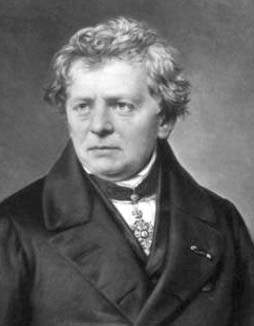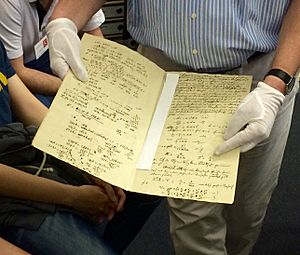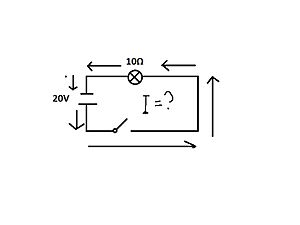Ohm's law facts for kids
Ohm's Law is a very important rule in electricity. It helps us understand how electricity moves through a circuit. Imagine electricity flowing like water in a pipe. Ohm's Law tells us how three main things are connected:
- Current (I): How much electricity is flowing. Think of it like how much water is flowing through the pipe.
- Voltage (V): How much "push" or energy is making the electricity flow. Think of it like the water pressure in the pipe.
- Resistance (R): How much the circuit tries to stop the electricity from flowing. Think of it like how narrow or bumpy the pipe is, making it harder for water to flow.
The law says that the current flowing through something is directly related to the voltage pushing it. This means if you increase the push (voltage), more electricity (current) will flow. It's also inversely related to the resistance. This means if you increase the resistance, less electricity will flow.
Georg Ohm, a German scientist, discovered this law. He found that these three things always follow a simple mathematical rule. You can write this rule in a few ways:
- Failed to parse (Missing <code>texvc</code> executable. Please see math/README to configure.): V = IR
- Failed to parse (Missing <code>texvc</code> executable. Please see math/README to configure.): I = \frac{V}{R}

Here, I is the current (measured in amperes), V is the voltage (measured in volts), and R is the resistance (measured in ohms).
Contents
Understanding Voltage, Current, and Resistance
What is Voltage?
Voltage is like the "electrical pressure" in a circuit. It's the amount of energy difference between two points. Imagine a battery: one end has a high charge, and the other has a lower charge. The difference between these two charges is the voltage.
The unit for voltage is the "volt." This unit is named after Alessandro Volta, an Italian scientist. He created the first chemical battery. We use the letter V to stand for voltage in formulas.
What is Current?
Current is how fast electric charge flows through a circuit. Think of it as the number of electrons moving past a point each second. The more electrons that flow, the higher the current.
The unit for current is the "ampere," often shortened to "amp." This unit is named after André-Marie Ampère, a French physicist. We use the letter I to stand for current.
What is Resistance?
Resistance is anything in a circuit that slows down the flow of electricity. It's like a bottleneck or a rough patch in a pipe. Resistors are used to control how much current flows. Without resistance, too much current could flow and damage the circuit.
A light bulb is a good example of a resistor. When electrons flow through the bulb, the resistance makes it heat up and glow. If the resistance is high, the light will be dimmer because less current can flow. The unit for resistance is the "ohm," shown by the Greek letter Ω (omega). It's named after Georg Ohm himself.
How Ohm's Law Helps Us
Ohm's Law is super useful for anyone working with circuits. It lets us figure out any one of the three values (voltage, current, or resistance) if we know the other two.
Finding Unknown Values in a Circuit
Let's say a scientist is working with a simple circuit.
She knows the voltage from the power source is 20 volts (20V). She also knows the light bulb in the circuit has a resistance of 10 ohms (10 Ω). She needs to find out how much current is flowing through the circuit.
She can use Ohm's Law to solve this! The formula she needs is:
- Failed to parse (Missing <code>texvc</code> executable. Please see math/README to configure.): I = \frac{V}{R}
Now, she just puts in the numbers she knows: I = 20V / 10Ω I = 2A
So, the current flowing through the circuit is 2 amperes (2 amps). This shows how Ohm's Law helps scientists and engineers design and fix electrical circuits every day!
See also
 In Spanish: Ley de Ohm para niños
In Spanish: Ley de Ohm para niños




